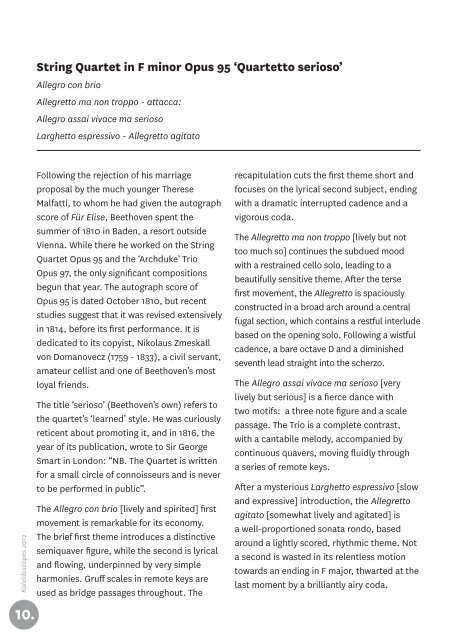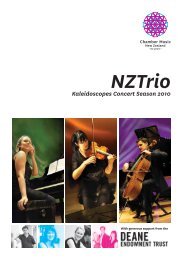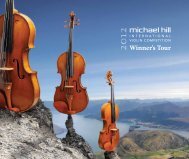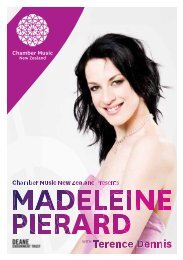BEETHOVEN! - Chamber Music New Zealand
BEETHOVEN! - Chamber Music New Zealand
BEETHOVEN! - Chamber Music New Zealand
Create successful ePaper yourself
Turn your PDF publications into a flip-book with our unique Google optimized e-Paper software.
Kaleidoscopes 2012<br />
10.<br />
String Quartet in F minor Opus 95 ‘Quartetto serioso’<br />
Allegro con brio<br />
Allegretto ma non troppo - attacca:<br />
Allegro assai vivace ma serioso<br />
Larghetto espressivo - Allegretto agitato<br />
Following the rejection of his marriage<br />
proposal by the much younger Therese<br />
Malfatti, to whom he had given the autograph<br />
score of Für Elise, Beethoven spent the<br />
summer of 1810 in Baden, a resort outside<br />
Vienna. While there he worked on the String<br />
Quartet Opus 95 and the ‘Archduke’ Trio<br />
Opus 97, the only signifi cant compositions<br />
begun that year. The autograph score of<br />
Opus 95 is dated October 1810, but recent<br />
studies suggest that it was revised extensively<br />
in 1814, before its fi rst performance. It is<br />
dedicated to its copyist, Nikolaus Zmeskall<br />
von Domanovecz (1759 - 1833), a civil servant,<br />
amateur cellist and one of Beethoven’s most<br />
loyal friends.<br />
The title ‘serioso’ (Beethoven’s own) refers to<br />
the quartet’s ‘learned’ style. He was curiously<br />
reticent about promoting it, and in 1816, the<br />
year of its publication, wrote to Sir George<br />
Smart in London: “NB. The Quartet is written<br />
for a small circle of connoisseurs and is never<br />
to be performed in public”.<br />
The Allegro con brio [lively and spirited] fi rst<br />
movement is remarkable for its economy.<br />
The brief fi rst theme introduces a distinctive<br />
semiquaver fi gure, while the second is lyrical<br />
and fl owing, underpinned by very simple<br />
harmonies. Gruff scales in remote keys are<br />
used as bridge passages throughout. The<br />
recapitulation cuts the fi rst theme short and<br />
focuses on the lyrical second subject, ending<br />
with a dramatic interrupted cadence and a<br />
vigorous coda.<br />
The Allegretto ma non troppo [lively but not<br />
too much so] continues the subdued mood<br />
with a restrained cello solo, leading to a<br />
beautifully sensitive theme. After the terse<br />
fi rst movement, the Allegretto is spaciously<br />
constructed in a broad arch around a central<br />
fugal section, which contains a restful interlude<br />
based on the opening solo. Following a wistful<br />
cadence, a bare octave D and a diminished<br />
seventh lead straight into the scherzo.<br />
The Allegro assai vivace ma serioso [very<br />
lively but serious] is a fi erce dance with<br />
two motifs: a three note fi gure and a scale<br />
passage. The Trio is a complete contrast,<br />
with a cantabile melody, accompanied by<br />
continuous quavers, moving fl uidly through<br />
a series of remote keys.<br />
After a mysterious Larghetto espressivo [slow<br />
and expressive] introduction, the Allegretto<br />
agitato [somewhat lively and agitated] is<br />
a well-proportioned sonata rondo, based<br />
around a lightly scored, rhythmic theme. Not<br />
a second is wasted in its relentless motion<br />
towards an ending in F major, thwarted at the<br />
last moment by a brilliantly airy coda.





